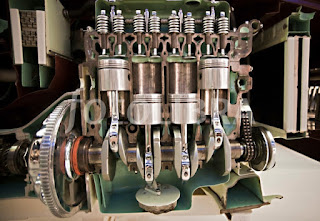The inner burning motors are actually the motors where the burning from a gas accompanies an oxidizer (normally air) in a burning enclosure that is actually an important aspect of the operating liquid circulation circuit. In an interior burning motor, the development from the heat and also high-pressure fuels made through ignition administer straight pressure to some element from the motor. The force is actually administered normally to engines, generator cutters or even a faucet.
In an interior burning motor the development from the heat as well as high-pressure fuels made through burning use straight pressure to some element from the motor. The force is actually administered usually to engines, wind turbine cutters or even a mist nozzle.
Principal of Operation:
Air-fuel blend in the ignition enclosure is actually sparked, either through a fuse (in the event from SI Engines) or even through squeezing (just in case from CI motors). This ignition generates incredible volume from heat and also stress inside the cylindrical tube. This causes returning the compliment movement in the engine.
Energy from the engine is actually sent to a crankshaft which goes through turning activity. The rotating activity is actually essentially broadcast to the steering wheels of the car, by means of a gear box device, to make power in the motor vehicle.
As the ignition happens internally inside the cylindrical tube (an aspect of functioning liquid circuit) the motor is actually contacted inner burning motor.
Energy from the engine is actually sent to a crankshaft which goes through turning activity. The rotating activity is actually essentially broadcast to the steering wheels of the car, by means of a gear box device, to make power in the motor vehicle.
As the ignition happens internally inside the cylindrical tube (an aspect of functioning liquid circuit) the motor is actually contacted inner burning motor.
Classification of Internal Combustion Engine:
1. Based on application
- Automobile Engine
- Aircraft Engine
- Locomotive Engine
- Marine Engine
- Stationary Engine
2. Based on basic engine design
- Reciprocating: Single cylinder, Multi-cylinder In-line, V, radial, opposed cylinder, Opposed Piston.
- Rotatory: Single motor, Multi motor
3. Based on operating cycle
- Atkinson (For complete expansion SI Engine)
- Diesel (For the Ideal Diesel Engine)
- Dual (For the Actual Diesel Engine)
- Miller (For Early/Late Inlet valve closing type SI Engine)
- Otto (For the Convectional SI Engine)
4. Based on working cycle
- Four stroke cycle
- Two stroke cycle
- Scavenging ; direct/crankcase/cross flow; back flow/loop; Uni flow
- Naturally aspirated or turbocharged
5. Based on Valve/port design and location
- Design of valve/port
- Poppet valve
- Rotatory valve
- Location of valve/port
- T-head
- L-head
- F-head
- L-head
6.Based on Fuel
- Convectional
- Crude oil derivatives; Petrol, diesel
- Other sources; coal, bio-mass, tar stands, shale
- Alternative
- Petroleum derived: CNG, LPG
- Bio-mass derived: alcohols, vegetable oils, producer gas, biogas and hydrogen
- Blending
- Bi-fuel and dual fuel
7. Based on mixture preparation
- Carburetion
- Fuel injection
8. Based on ignition
- Spark ignition
- Compression Ignition
9. Based on stratification of charge
- Homogeneous Charge
- Stratified charge
- With carburetion
- With fuel injection
10. Based on combustion chamber design
- Open chamber: Disc, wedge, hemispherical, bowl-in-piston, bath tub.
- Divided chamber:
- (For CI) 1. Swirl chamber, 2. Pre-chamber
- (for SI) 1. CVCC, 2. Other designs
11. Based on cooling system
- Air-cooling system
- Water-cooling system

No comments :
Post a Comment